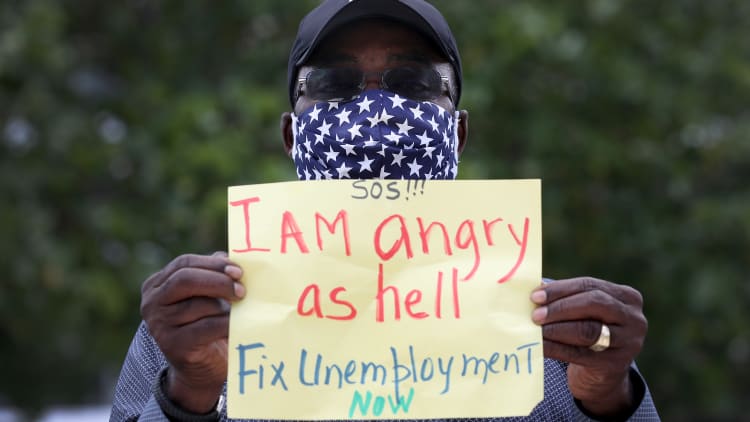The Senate's Health, Economic Assistance, Liability Protection and Schools, or HEALS, Act, proposes a cut from $600 to $200 per week in enhanced unemployment through September, which will impact some 32 million Americans currently receiving jobless benefits.
The new proposed $200 enhancement will work in the same way the previous $600 bonus from the CARES Act worked: Workers will receive their regular state-administered unemployment aid, which ranges from an average $497 in Washington to just $44 in Oklahoma on its own, and will get an additional $200 per week paid by the federal government on top.
What comes next, however, is different. The Republican proposal says that by October, the flat $200 federal boost will be replaced with a payment that, when combined with regular state benefits, will recover 70% of workers' previous wages. The replacement rate will be calculated either by a formula specified in the bill or by a state proposing an alternative method and receiving approval from the Secretary of Labor. That means the method of calculating a 70% replacement wage could vary by state. Boosts will be capped at $500 per week.
Replacement calculations could cause delays in payment
Critics of the 70% replacement plan say state unemployment offices simply will not be able to calculate benefits and deliver them in a timely manner. Every state uses a different set of formulas to calculate a recipient's unemployment benefit, which is based on the applicant's earning history from the previous four quarters and must verified by their former employer. Each state also has a minimum and maximum they can provide in unemployment.
"It's not like everyone has a flat replacement rate in any state, so that's an issue," Michele Evermore, a senior policy analyst at the National Employment Law Project, tells CNBC Make It.
Take two people who live in New York, where the maximum unemployment benefit is $504. A recipient who used to earn roughly $52,000 per year will receive the full $504 weekly benefit, which replaces about 50% of their wages. A recipient who used to earn $104,000 per year can still only qualify for a max of $504 in aid per week, effectively replacing 25% of their previous wages.
For the lower earner to receive a total 70% replacement wage with federal aid, a calculation will have to determine how they would receive an additional $196 per week from the relief bill. The higher earner, in order to get to a 70% replacement with enhanced unemployment, would need an extra $896 in federally funded aid. The proposal stipulates that extra payments cannot exceed $500 however, so this person would receive lower than a 70% replacement with boosted unemployment.

"Every single person is going to have to get a different multiplier added to their replacement rate" to meet the proposed 70% standard, Evermore explains. Making these individual calculations at the state level for millions of people per week will likely result in technical challenges and delays. Even the previous $600 passed in the CARES Act took a full month to roll out to all 50 states and the District of Columbia.
Furthermore, the proposal's assumption that states will be able to reprogram their unemployment systems within two months, by October, to run a new benefit for the remainder of the year could prove untenable.
The switch could take up to five months in many states — after they receive Department of Labor guidance — according to a memo prepared by the National Association of State Workforce Agencies obtained by Bloomberg News.
What happens if state unemployment offices can't reprogram their systems in time
If states are unable to program systems to provide a 70% replacement wage to workers by October 5, they can apply for a waiver from the Department of Labor to continue paying the fixed $200 for up to two months. It remains to be seen what would happen if a state is unable to get the 70% calculation programmed by early December, as enhanced unemployment under the HEALS proposal expires at the end of the year.
Evermore says the 70% replacement rate doesn't seem like a serious proposal, and that it might instead be an entry figure for Republicans to kick off negotiations with Democrats in the coming days. She says it would take state unemployment offices two to four weeks to simply reauthorize another flat federal benefit now that the weekly $600 boost has lapsed.
Outdated state labor systems have already faced an onslaught of months of historically high claims. Due to the crush of demand on strained systems, just 57% of claims — 18.8 million out of 33 million — had been paid nationwide by the end of May, according to data compiled by Andrew Stettner, a senior fellow at The Century Foundation.
Not all unemployment recipients have the earning history to calculate a replacement wage
The 70% replacement calculation also raises concerns about how people newly eligible for unemployment, including the self-employed, freelancers, gig workers and those without enough earning history, will receive aid. These workers don't generally have the documentation required to qualify for unemployment to begin with, so it remains to be seen how their 70% replacement will be drawn up.
"Measuring 70% [wage replacement] will present quite serious administrative challenges for states, since in many cases they don't have a good measure of a person's average earnings based on the previous year," says Wayne Vroman, a labor economist with the Urban Institute. "I would guess states will have to go through hoops to get information on that,"
It's possible lawmakers intend to take the 70% replacement wage, or another negotiated rate, and apply it broadly to the national average unemployment benefit. For example, the previous $600 weekly boost approved in March was determined as the 100% replacement wage for the average worker. That way it wouldn't be left to state offices to crunch the numbers on a person-to-person basis.
According to a CNBC analysis, a 70% replacement rate could come out to a flat enhancement of $310 per person per week.

"Either way, the 70% replacement is a weird technocratic solution to a problem that doesn't exist," Evermore says, referring to lawmakers who want to end and replace the current $600 enhancement. Critics of the current benefit say it discourages people from returning to work, given nearly two-thirds of people earn more on unemployment than they did from previous wages. Many economists disagree with the assertion.
The HEALS Act also proposes sending $2 billion to states to upgrade their unemployment insurance systems to be better able to handle a surge in claims, adjust wage replacement levels and automate a number of processes currently done manually. However, Evermore stresses this call for increased funding for an unemployment IT overhaul pre-dates the new need to calculate a 70% replacement wage as outlined in the proposal.
As drafted in the HEALS Act, three unemployment policies created in March, including a weekly unemployment boost, a wider pool of eligibility, and a 13-week extension on top of state aid, will all expire December 31, 2020.
CNBC Make It is NOW STREAMING on Peacock. Find our original programming in the Channels section.
Don't miss:



